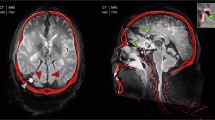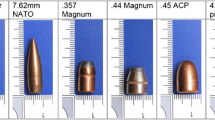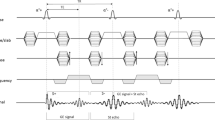Abstract
Purpose
The fact that ferromagnetic bullets can move in air or gelatine when subjected to magnetic resonance (MR) units is well known. A previous study showed that the movement of 7.5-mm GP 11 Suisse bullets also depends on their orientation toward the gantry. In order to compare the movement in gelatine to that in real tissue, we decided to measure the movement of these bullets, as well as 9-mm Luger bullets, in the brain and liver.
Methods
The GP 11 and 9-mm Luger bullets were inserted into the fresh calf brain or pig liver either vertically or horizontally in the x- or z-axis to the gantry. Before and after exposure to a 3-T MR unit, their position was documented by CT.
Results
GP 11 bullets rotated more readily and in general proved to be more mobile than the 9-mm Luger. All GP 11 bullets and a large amount of the 9-mm Luger bullets exited the brain. Sliding toward the gantry was easier for 9-mm Luger bullets in the brain than in the liver.
Conclusions
The orientation of a ferromagnetic object influences its mobility in a strong magnetic field. Tipping is easier than sliding for longish ferromagnetic projectiles, probably due to the lesser tissue resistance. The bullets moved more readily in biological tissue, especially brain tissue, compared to gelatine, thus implying that gelatine is not a suitable substitute for soft tissues when examining the movement of ferromagnetic objects in MR units.



Similar content being viewed by others
References
American College of Radiology (2016) ACR Appropriateness Criteria®. https://acsearch.acr.org/docs/69434/Narrative/. Accessed Dec 2nd
Flach PM, Schroth S, Schweitzer W, Ampanozi G, Slotboom J, Kiefer C, Germerott T, Thali MJ, El-Koussy M (2015) Deep into the fibers! Postmortem diffusion tensor imaging in forensic radiology. Am J Forensic Med Pathol. 36(3):153–161
Kumar R, Lerski RA, Gandy S, Clift BA, Abboud RJ (2006) Safety of orthopedic implants in magnetic resonance imaging: an experimental verification. J Orthop Res 24(9):1799–1802
Shellock FG (2001) Metallic neurosurgical implants: evaluation of magnetic field interactions, heating, and artifacts at 1.5-tesla. J Magn Reson Imaging 14(3):295–299
Dedini RD, Karacozoff AM, Shellock FG, Xu D, McClellan RT, Pekmezci M (2013) MRI issues for ballistic objects: information obtained at 1.5-, 3- and 7-tesla. Spine J 13(7):815–822
Teitelbaum GP (1990) Metallic ballistic fragments: MR imaging safety and artifacts. Radiology 177(3):883
Smugar SS, Schweitzer ME, Hume E (1999) MRI in patients with intraspinal bullets. J Magn Reson Imaging 9(1):151–153
Martinez-del-Campo E, Rangel-Castilla L, Soriano-Baron H, Theodore N (2014) Magnetic resonance imaging in lumbar gunshot wounds: an absolute contraindication? Neurosurg Focus 37(1):E13
MRISafety.com, Shellock R & D Services, Inc. and Frank G. Shellock, Ph.D, http://www.mrisafety.com/TheList_search.asp. Accessed December 2nd, 2016
Eggert S, Kubik-Huch RA, Lory M, Froehlich JM, Gascho D, Thali MJ, Bolliger SA (2015) The influence of 1.5 and 3 T magnetic resonance unit magnetic fields on the movement of steel-jacketed projectiles in ordnance gelatin. Forensic Sci Med Pathol 11(4):544–551
Teitelbaum GP, Yee CA, Van Horn DD, Kim HS, Colletti PM (1990) Metallic ballistic fragments: MR imaging safety and artifacts. Radiology 175(3):855–859
Smith AS, Hurst GC, Duerk JL, Diaz PJ (1991) MR of ballistic materials: imaging artifacts and potential hazards. AJNR Am J Neuroradiol 12(3):567–572
Karacozoff AM, Pekmezci M, Shellock FG (2013) Armor-piercing bullet: 3-T MRI findings and identification by a ferromagnetic detection system. Mil Med 178(3):e380–e385
Diallo I, Auffret M, Attar L, Bouvard E, Rousset J, Ben Salem D (2016) Magnetic field interactions of military and law enforcement bullets at 1.5 and 3 tesla. Mil Med 181(7):710–713
Kneubuehl BP (2011) Simulants. In: Kneubuehl BP, Coupland RM, Rothschild MA, Thali MJ (eds) Wound ballistics. Basics and applications, 1st edn. Springer, Berlin, Heidelberg, New York, pp 136–156
Fackler ML, Malinowski JA (1985) The wound profile: a visual method for quantifying gunshot wound components. J Trauma 25(6):522–529
Thali MJ, Kneubuehl BP, Vock P, Allmen G, Dirnhofer R (2002) High-speed documented experimental gunshot to a skull-brain model and radiologic virtual autopsy. Am J Forensic Med Pathol 23:223–228
Gawlick H, Knappworst J. (1975) Zielballistische Untersuchungsmethoden an Jagdbüchsengeschossen. Ballistisches Laboratorium für Munition der Dynamit Nobel AG, Werk Stadeln
Ragsdale BD, Josselson A (1988) Predicting temporary cavity size from radial fissure measurements in ordnance gelatin. J Trauma 28(1 Suppl):S5–S9
Bolliger SA, Ampanozi G, Kneubuehl BP, Thali MJ (2014) Gunshot to the pelvis—experimental ballistics and forensic radiology. J Forensic Radiology and Imaging 2:17–19
Bolliger SA, Thali MJ, Bolliger MJ, Kneubuehl BP (2010) Gunshot energy transfer profile in ballistic gelatine, determined with computed tomography using the total crack length method. Int J Legal Med 124(6):613–616
Jussila J, Leppäniemi A, Paronen M, Kulomäki E (2005) Ballistic skin simulant. Forensic Sci Int 150(1):63–71
Sterzik V, Kneubuehl BP, Bohnert M, Riva F, Glardon M (2017) Bullet fragmentation preceding a contour shot: case study and experimental simulation. Int J Legal Med 131(1):173–177
Schyma C, Lux C, Madea B, Courts C The ‘triple contrast’ method in experimental wound ballistics and backspatter analysis. Int J Legal Med 129(5):1027–1033
Luijten M, Haest II, van Kan RA, van Lohuizen W, Kroll J, Schnerr RS, Hermsen R, Hofman PA (2016) Can postmortem MRI be used to assess trajectories in gunshot victims? Int J Legal Med 130(2):457–462
Shellock FG, Woods TO, Crues JV (2009) MR labeling information for implants and devices: explanation of terminology. Radiology 253(1):26–30
Acknowledgements
The authors would like to thank the late Emma Louise Kessler, MD, whose legacy supported this study financially. We are also indebted to Clemens Bauer, head of veterinary services, City of Zurich, for helping us acquire the calf brains and pig livers and Adrian M. Bolliger, PhD, for language editing.
Author information
Authors and Affiliations
Corresponding author
Additional information
In loving memory of my father Werner Bolliger, PhD, 1941–2016
Rights and permissions
About this article
Cite this article
Bolliger, S.A., Thali, M.J., Gascho, D. et al. Movement of steel-jacketed projectiles in biological tissue in the magnetic field of a 3-T magnetic resonance unit. Int J Legal Med 131, 1363–1368 (2017). https://doi.org/10.1007/s00414-017-1574-x
Received:
Accepted:
Published:
Issue Date:
DOI: https://doi.org/10.1007/s00414-017-1574-x




